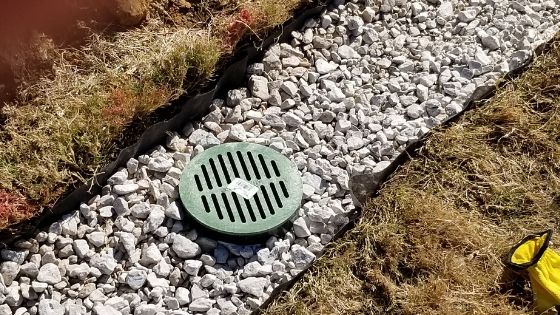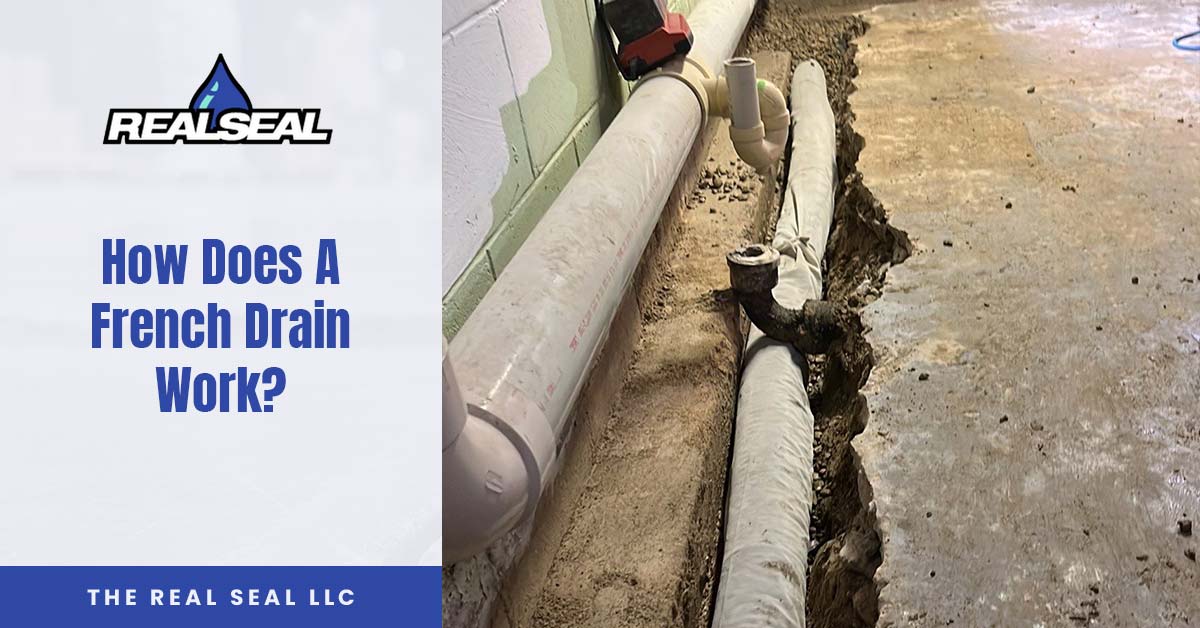The Vital Guide to Preserving Your French Drain for Durable Efficiency
Keeping your French drainpipe is crucial to its effectiveness and your property's security. Routine checks can save you from costly repairs and water damages. You'll need to know what signs to look for and just how usually to evaluate your system. And also, recognizing the cleansing process can make a significant distinction. Allow's explore the essential actions for guaranteeing your drain functions well for several years to come.
Recognizing the Feature of a French Drainpipe
A French drainpipe is an important component in taking care of water around your home. It routes excess water far from your foundation, stopping flooding and damage. When hefty rainfall falls, the drain gathers water with a perforated pipeline buried in gravel. This system permits water to move freely, lowering pressure on your basement wall surfaces and lessening the danger of leaks.You might wonder how it functions in method. As water saturates the soil, gravity pulls it toward the drainpipe. The perforated pipe captures this water, carrying it to an assigned drainage area or storm sewer. This procedure maintains your lawn dry and protects your home's structural integrity.Understanding just how a French drainpipe features is essential to valuing its value. By successfully carrying water away, it aids keep a safe and dry living setting. Maintaining your French drain in leading condition assurances you avoid pricey fixings down the line.
Regular Examinations: What to Look For
When you're examining your French drain, start by examining for any type of obstructions that could be obstructing water flow. Focus on indications of surface area erosion around the drainpipe, as this can suggest possible concerns. Normal assessments will assist maintain your water drainage system operating effectively.
Obstructed Drainpipe Analysis
Just how can you inform if your French drainpipe is obstructed? First, look for water merging in your lawn, especially after heavy rain. If you observe locations where water accumulates rather of draining, that's a red flag. You should also inspect the drainpipe electrical outlet; if water isn't spurting as it should, there's most likely an obstruction. Listen for unusual gurgling sounds, which can indicate trapped air. Additionally, evaluate the drainpipe's surface area for any kind of vegetation development, as origins can clog the system and penetrate. If you smell mildewy odors, it might direct to stagnant water caused by a clog. Routinely reviewing these indicators can aid you preserve your French drain efficiently and stop costly fixings.
Surface Area Erosion Examine

Cleaning Your French Drain: Step-by-Step Overview
Cleansing your French drain is essential for maintaining it functioning effectively. You'll require some certain tools and a clear process to assure everything runs efficiently. Let's go through the steps and suggestions for keeping your drain effectively.
Tools You'll Need
To deal with the job of cleaning your French drain successfully, you'll desire to collect a couple of essential tools. Initially, order a sturdy pair of gloves to protect your hands from debris and sharp items. A tiny shovel or trowel will help you eliminate dirt or blockages around the drain. For removing the inside, a plumbing technician's serpent or a high-pressure water nozzle can be unbelievably useful. You'll additionally require a pail for accumulating any debris you draw out. Ultimately, having a yard pipe handy will certainly make it less complicated to wash out the drain and guarantee it's flowing efficiently. With these tools all set, you'll be set for a thorough cleansing session!
Cleaning Refine Actions
Start by assessing the area around your French drainpipe for any type of visible debris or clogs. Eliminate leaves, branches, or dust that might obstruct water flow. Next, examine the inlet and outlet areas; clear any obstructions to guarantee correct drain. Use a yard pipe to flush the drainpipe, guiding water into the inlet. This aids dislodge any kind of gathered sludge or sediment. If you notice relentless obstructions, take into consideration utilizing a plumbing's serpent to break them up. After cleansing, examine the crushed rock around the drain; renew it if it's removed. Ultimately, validate the drain covers are undamaged and securely in area to avoid particles from entering. Routine cleansing keeps your French drain operating efficiently.
Upkeep Regularity Tips
While regular upkeep is necessary for your French drain's durability, recognizing how typically to keep it can make all the difference. Preferably, you ought to check your French drainpipe at the very least twice a year, preferably in spring and fall. After hefty rainfall or snowmelt, look for clogs or debris. If you see any standing water, it's time to cleanse your drain.In areas with hefty foliage, more constant maintenance-- concerning every three months-- may be required. In addition, think about cleansing your French drainpipe after major tornados or go to my site if you observe water pooling in your lawn. By staying proactive, you'll assure your French drain functions effectively and secures your residential property from water damages. Regular checks will certainly conserve you time and cash in the long run.
Identifying Common Problems and Their Solutions
It's vital to identify common concerns with your French drainpipe and carry out efficient services when you observe water merging in your backyard or damp places in your cellar. One frequent trouble is visit site blocking, typically created by debris like leaves or debris. To repair this, you can use a pipes snake or a high-pressure water jet to clear blockages.Another issue may be incorrect slope. If your drainpipe isn't sloped appropriately, water will not stream away from your home. You can adjust the slope by digging and rearranging the drain pipe.Lastly, check for damages or cracks in the drainpipe itself. If you locate any, changing the damaged areas is essential for peak performance. By dealing with these concerns immediately, you'll help assure that your French drain remains to function properly, shielding your residential or commercial property from water damages and preserving a completely dry, safe setting.
Seasonal Maintenance Tips for Your French Drain
Dealing with usual issues with your French drainpipe is just the very first step in assuring its long-term effectiveness. Seasonal upkeep is essential for peak efficiency. In the springtime, clear away leaves and particles that may have gathered during wintertime. Examine for any kind of clogs in the outlet or capture container, as water needs a clear path to stream freely.During summertime, inspect your drain for any type of indicators of working out or moving dirt. Make sure it's still degree and functioning appropriately. As loss approaches, clean any type of dropped entrusts to prevent clogs before wintertime arrives.In winter, look for freezing temperature levels. Make certain your drainpipe isn't at threat of cold if you live in a cool climate. Protecting revealed pipelines can aid. Normal checks and timely maintenance can prevent pricey fixings and maintain your French drainpipe functioning successfully year-round. Keep positive and enjoy peace of mind knowing your drainage system is in good condition!
When to Call in a Specialist
Knowing when to hire a professional can conserve you time and protect against additional damage to your French drain. It's a clear indicator that your drainpipe might be clogged or harmed if you observe consistent standing water in your yard. Do not Homepage neglect unusual odors, as they can suggest sewage back-up or decay, which requires prompt attention.If you discover that your drainpipe isn't working correctly after attempts to tidy or maintain it, it's time to get to out for professional aid. In addition, if you're unclear concerning the underlying problems or do not have the needed tools, employing a professional can offer tranquility of mind.Finally, if your French drain is old or has actually experienced considerable wear and tear, expert assessment can identify whether repairs or total replacement is needed. Trust fund the professionals to assure your drain system works successfully for years ahead.
Tips for Avoiding Future Water Drainage Problems
To keep your French drain working successfully, consistently examining and preserving it can make all the distinction. Start by clearing particles, leaves, and dust from the surface and drain openings. This protects against blockages that can result in water backup. Inspect the crushed rock around the drain; if it's compacted or worn down, take into consideration including fresh gravel to preserve ideal flow.Next, divert water far from your drain by making certain gutters and downspouts are clear and guiding water a minimum of three feet far from your structure. On a regular basis check for any kind of indicators of damage or sagging. If you discover problems, address them immediately.Finally, take into consideration mounting a filter or a catch basin to catch bigger particles before it goes into the drain. By staying positive with these pointers, you'll decrease the threat of future water drainage problems and maintain your French drainpipe in top shape.
Frequently Asked Questions
The length of time Does a French Drainpipe Typically Last?
A French drain usually lasts around 30 to 40 years, depending upon the materials used and maintenance (Portland French Drain). If you stay on par with normal checks, you can expand its life-span also additionally
Can I Set Up a French Drain Myself?
Yes, you can install a French drainpipe on your own if you have actually obtained the right tools and knowledge. Simply make particular to intend meticulously, comply with regional policies, and guarantee proper water drainage to prevent future issues.
What Materials Are Made Use Of in a French Drainpipe?
You'll need perforated pipe, crushed rock, landscape material, and a solid water drainage pipe for your French drainpipe. These materials help reroute water effectively, stopping flooding and maintaining your residential or commercial property safe and completely dry from water damage.

Is a Permit Required to Install a French Drainpipe?
You'll likely require an authorization to mount a French drainpipe, relying on local regulations. Get in touch with your municipality to assure you follow any kind of needed standards and stay clear of prospective problems during installation.
What Are the Prices Connected With French Drainpipe Maintenance?
Preserving a French drain usually costs between $100 and $500 each year. You'll require to take into consideration expenses for cleansing, fixings, and examinations. Routine maintenance aids protect against larger warranties and expenditures your system works properly for several years - Portland French Drain. When you're checking your French drain, beginning by inspecting for any obstructions that may be obstructing water circulation. By staying aggressive, you'll ensure your French drain functions effectively and secures your residential property from water damage. When you see water pooling in your backyard or damp areas in your cellar, it's crucial to identify usual issues with your French drainpipe and implement reliable services. You can change the slope by excavating and rearranging the drain pipe.Lastly, check for damages or splits in the drain itself. Examine the gravel around the drainpipe; if it's compressed or deteriorated, consider including fresh gravel to maintain perfect flow.Next, draw away water away from your drainpipe by guaranteeing seamless gutters and downspouts are clear and routing water at the very least 3 feet away from your structure